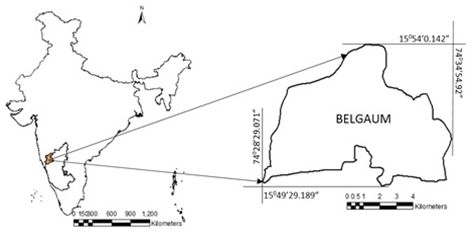 |
Land use Land Cover Dynamics in a rapidly urbanizing Landscape |
 |
1Energy and Wetlands Research Group, Centre for Ecological Sciences [CES],
2Centre for Sustainable Technologies, 3Centre for infrastructure, Sustainable Transportation and Urban Planning (CiSTUP),
Indian Institute of Science, Bangalore – 560012, India.
*Corresponding author: cestvr@ces.iisc.ac.in
|
Study Area
Belgaum City (Fig.1) geographically located in the North Western Part of Karnataka State. The city with the spatial extent of about 58 sq.km. Extends from 74o28’29.071” E to 74o34’54.92” E and 15o49’23.189” N to 15o54’0.142” N with an average elevation of 751m above mean sea level. Five km buffer from the administrative boundary was considered as shown in Fig. 2 (with a gross area of 38 sq.km) to account for developments in the peri urban regions. The city has about 58 Wards, with population of 488292 (2011 Census Provisional)[19] and Population Density of 84.21 persons per hectare. Population has a decadal increase of 7.31%. BUDA (Belgaum Urban Development Authority) formed during 1988 is responsible for urban development including layout and town planning [25]. BUDA consists of local planning area of 182 sq.km, which includes the Belgaum city corporation, 26 surrounding villages and regions under conurbation limit. BUDA since 1988 has developed about 19 townships [26]. Temperature varies from 18 oC (winter) to 40 oC (summer) and city receives annual average rainfall of 1418 mm. Soils in the region consist of shallow to very deep black soils, red loamy soils, lateritic soils etc. The city is surrounded by Kanburgi, Yamanspura, Kangrali.B, Kangrali.K villages in the north, Hindalga, Binakanahalli, Savagaon, Madoli in the West, Angol, Wadgaon, Madhavapura, Haldge in the South and Sindoli, Mutuge, Nilage Villages in the East [27].

Figure 1. Belgaum City Administrative Boundary
|
|
Citation : Ramachandra T V, Bharath H Aithal and Vinay S., Land Use Land Cover Dynamics in a Rapidly Urbanising Landscape, SCIT Journal, Volume XIII, August 2013, pp 1-12
|


